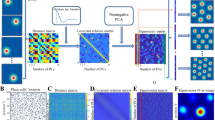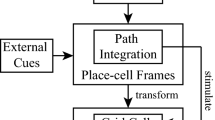Abstract
Grid cells in the entorhinal cortex, together with head direction, place, speed and border cells, are major contributors to the organization of spatial representations in the brain. In this work we introduce a novel theoretical and algorithmic framework able to explain the optimality of hexagonal grid-like response patterns. We show that this pattern is a result of minimal variance encoding of neurons together with maximal robustness to neurons’ noise and minimal number of encoding neurons. The novelty lies in the formulation of the encoding problem considering neurons as an overcomplete basis (a frame) where the position information is encoded. Through the modern Frame Theory language, specifically that of tight and equiangular frames, we provide new insights about the optimality of hexagonal grid receptive fields. The proposed model is based on the well-accepted and tested hypothesis of Hebbian learning, providing a simplified cortical-based framework that does not require the presence of velocity-driven oscillations (oscillatory model) or translational symmetries in the synaptic connections (attractor model). We moreover demonstrate that the proposed encoding mechanism naturally explains axis alignment of neighbor grid cells and maps shifts, rotations and scaling of the stimuli onto the shape of grid cells’ receptive fields, giving a straightforward explanation of the experimental evidence of grid cells remapping under transformations of environmental cues.




Similar content being viewed by others
References
Aapo, H., Hoyer, P.O., Hurri, J. (2009). Natural image statistics: a probabilistic approach to early computational vision. Book.
Banino, A, & et al. (2018). Vector-based navigation using grid-like representations in artificial agents. Nature, 557, 05.
Bicanski, A, & Burgess, N. (2019). A computational model of visual recognition memory via grid cells. Current Biology, 29(6), 979–990, e4.
Blair, H.T., Welday, A.C., Zhang, K. (2007). Scale-invariant memory representations emerge from moire interference between grid fields that produce theta oscillations: a computational model. Journal of Neuroscience, 27, 3211–3229.
Burak, Y., & Fiete, I.R. (2009). Accurate path integration in continuous attractor network models of grid cells. PLoS Computational Biology, 5.
Burgess, N., Barry, C., O’Keefe, J. (2007). An oscillatory interference model of grid cell firing. Hippocampus, 17, 801–812.
Carandini, M, & Heeger, D.J. (2011). Normalization as a canonical neural computation. Nature Reviews Neuroscience, 13(1), 51–62.
Casazza, G.P., Fickus, M., Kovačević, J., Leon, M.T., Tremain, C.J. (2006). A physical interpretation of tight frames. Harmonic analysis and applications. Applied and Numerical Harmonic Analysis.
Castro, L, & Aguiar, P. (2014). A feedforward model for the formation of a grid field where spatial information is provided solely from place cells. Biological Cybernetics, 108(2), 133–143.
Cheng, D. (2018). Hexadirectional modulation of theta power in human entorhinal cortex during spatial navigation. Current Biology, 28, 20, 3310–3315.
Constantinescu, A.O., O’Reilly, J.X., Behrens, T.E.J. (2016). Organizing conceptual knowledge in humans with a gridlike code. Science, 352, 1464–1468.
Deneve, S., Peter, E., Latham, Alexandre, P. (1999). Reading population codes: a neural implementation of ideal observers. Nature Neuroscience, 2(8), 740–745.
Dordek, Y, Soudry, D, Meir, R, Derdikman, D. (2016). Extracting grid cell characteristics from place cell inputs using non-negative principal component analysis. eLife, 5, e10094.
Eagleson, R. (1992). Measurement of the 2D affine Lie group parameters for visual motion analysis. Spatial Vision, 6, 3.
Field, D.J. (1999). Wavelets, vision and the statistics of natural scenes. Philosophical Transactions, Mathematical, Physical and Engineering Sciences, 357(1760), 2527.
Fiete, I.R., Burak, Y, Brookings, T. (2008). What grid cells convey about rat location. Journal of Neuroscience, 28(27), 6858–6871.
Franzius, M, Sprekeler, H, Wiskott, L. (2007). Slowness and sparseness lead to place, head-direction, and spatial-view cells. Plos Computational Biology, 3(8), 1605–1622.
Fuhs, M.C., & Touretzky, D.S. (2006). A spin glass model of path integration in rat medial entorhinal cortex. Journal of Neuroscience, 6, 4266–4276.
Goyal, V.K., & Kovacevic, J. (2001). Quantized frame expansions with erasures. Applied and Computational Harmonic Analysis, 10, 203–233.
Hafting, T., Fyhn, M., Molden, S., Moser, M.-B., Moser, E.I. (2005). Microstructure of a spatial map in the entorhinal cortex. Nature, 436, 801–806.
Hasselmo, M.E., Giocomo, L.M., Zilli, E.A. (2007). Grid cell firing may arise from interference of theta frequency membrane potential oscillations in single neurons. Hippocampus, 17, 1252–1271.
Hebb, D.O. (1949). The organization of behavior: a neuropsychological theory. Wiley.
Heys, J.G., MacLeod, K.M., Moss, C.F., Hasselmo, M.E. (2013). Bat and rat neurons differ in theta frequency resonance despite similar coding of space. Science, 340, 363–367.
Hubel, DH, & Wiesel, TN. (1965). Receptive fields and functional architecture in two nonstriate visual areas (18 and 19) of the cat. Journal of Neurophysiology, 28(2), 229.
Hubel, DH, & Wiesel, TN. (1968). Receptive fields and functional architecture of monkey striate cortex. The Journal of Physiology, 195(1), 215.
Jacobs, J. (2013). Direct recordings of grid-like neuronal activity in human spatial navigation. Nature Neuroscience, 16, 1188–1190.
Kay, S.M. (1993). Fundamentals of statistical signal processing: estimation theory. New Jersey: Englewood Cliffs.
Keinath, A, Epstein, R.A., Balasubramanian, V. (2018). Environmental deformations dynamically shift the grid cell spatial metric. eLife, 7, 10.
Kim, M. (2019). Can we study 3d grid codes non-invasively in the human brain? Methodological considerations and fmri findings. NeuroImage, 186, 667–678.
Kovacevic, J., & Chebira, A. (2007). Life beyond bases: the advent of frames (part i). IEEE Signal Processing Magazine, 24(4), 86–104.
Kropff, E., & Treves, A. (2008). The emergence of grid cells: intelligent design or just adaptation? Hippocampus, 18, 1256–1269.
Krupic, J., Bauza, M., Burton, S., Lever, C., O’Keefe, J. (2014). How environment geometry affects grid cell symmetry and what we can learn from it. Philosophical Transactions of the Royal Society of London, 369.
Krupic, J, Burgess, N, O’Keefe, J. (2012). Neural representations of location composed of spatially periodic bands. Science, 337(6096), 853–857.
Mathis, A, Herz, A.V.M., Stemmler, M. (2012). Optimal population codes for space: grid cells outperform place cells. Neural Computation, 24(9), 2280–2317.
McNaughton, B.L., Battaglia, F.P., Jensen, O., Moser, E.I., Moser, M.B. (2006). Path integration and the neural basis of the ’cognitive map’. Nature Reviews in the Neurosciences, 7, 663–678.
Mhatre, H, Gorchetchnikov, A, Grossberg, S. (2012). Grid cell hexagonal patterns formed by fast self-organized learning within entorhinal cortex. Hippocampus, 22(2), 320–334.
Moser, E.I., & Moser, M.-B. (2013). Grid cells and neural coding in high-end cortices. Neuron, 80.
Moser, E.I., Roudi, Y., Witter, M.P., Kentros, C, Bonhoeffer, T, Moser, M.-B. (2014). Grid cells and cortical representation. Nature Reviews Neuroscience, 15, 466–481.
Oja, E. (1982). Simplified neuron model as a principal component analyzer. Journal of Mathematical Biology, 15(3), 267–273.
Oja, E. (1992). Principal components, minor components, and linear neural networks. Neural Networks, 5(6), 927–935.
Orchard, J, Yang, H, Ji, X. (2013). Does the entorhinal cortex use the fourier transform? Frontiers in Computational Neuroscience, 7, 179.
Renart, A., Song, P., Wang, X.J. (2003). Robust spatial working memory through homeostatic synaptic scaling in heterogeneous cortical networks. Neuron, 38, 473–485.
Domínguez, U.R., & Caplan, J.B. (2018). A hexagonal fourier model of grid cells. Hippocampus, 09.
Sargolini, F, Fyhn, M, Hafting, T, McNaughton, B.L., Witter, M.P., Moser, M -B, Moser, E.I. (2006). Conjunctive representation of position, direction, and velocity in entorhinal cortex. Science, 312(5774), 758–762.
Schmidt-Hieber, C., & Häusser, M. (2013). Cellular mechanisms of spatial navigation in the medial entorhinal cortex. Nature Neuroscience, 16, 325–331.
Botvinick, M. M., Stachenfeld, K. L., Gershman, S. J. (2017). The hippocampus as a predictive map. Nature Neuroscisnce.
Stachenfeld, K.L., Botvinick, MM, Gershman, SJ. (2017). The hippocampus as a predictive map. Nature Neuroscience, 20, 1643–1653.
Staudigl, T, Leszczynski, M, Jacobs, J, Sheth, S.A., Schroeder, C.E., Jensen, O, Doeller, C.F. (2018). Hexadirectional modulation of high-frequency electrophysiological activity in the human anterior medial temporal lobe maps visual space. Current Biology, 28(20), 3325–3329.e4.
Urdapilleta, E., Troiani, F., Stella, F., Treves, A. (2015). Can rodents conceive hyperbolic spaces? Journal of the Royal Society Interface, 12, 107.
Vágó, L., & Ujfalussy, B.B. (2018). Robust and efficient coding with grid cells. PLOS Computational Biology, 14(1), 1–28.
Yartsev, M.M., Witter, M.P., Ulanovsky, N. (2011). Grid cells without theta oscillations in the entorhinal cortex of bats. Nature, 479, 103–107.
Yoon, H, & Sompolinsky, H. (1998). The effect of correlations on the fisher information of population codes. In Proceedings of the 11th International Conference on Neural Information Processing Systems, NIPS 98 (pp. 167–173). Cambridge: MIT Press.
Acknowledgements
M. M. M. is supported by grants from the Swiss National Science Foundation (grant 320030-169206), the Fondation Asile des aveugles, and a grantor advised by Carigest SA. B. F. is supported by the Fondation Asile des aveugles. F. A. acknowledges the Center for Brains, Minds and Machines (CBMM), funded by NSF STC award CCF-1231216 and the financial support of the AFOSR projects FA9550-17-1-0390 and BAA-AFRL-AFOSR-2016-0007 (European Office of Aerospace Research and Development), and the EU H2020-MSCA-RISE project NoMADS - DLV-777826. F. A. is also supported by the Italian Institute of Technology.
Author information
Authors and Affiliations
Contributions
F.A conceptualized the problem. F. A. and B.F. developed, implemented, and tested the model. F.A , B.F and M. M. M. wrote the manuscript.
Corresponding author
Additional information
Action Editor: Alessandro Treves
Publisher’s note
Springer Nature remains neutral with regard to jurisdictional claims in published maps and institutional affiliations.
Rights and permissions
About this article
Cite this article
Anselmi, F., Murray, M.M. & Franceschiello, B. A computational model for grid maps in neural populations. J Comput Neurosci 48, 149–159 (2020). https://doi.org/10.1007/s10827-020-00742-9
Received:
Revised:
Accepted:
Published:
Issue Date:
DOI: https://doi.org/10.1007/s10827-020-00742-9




